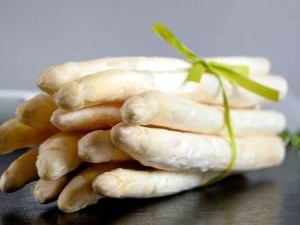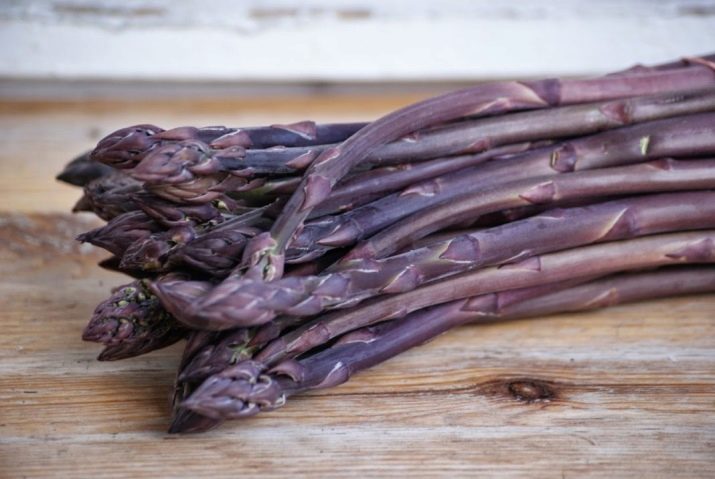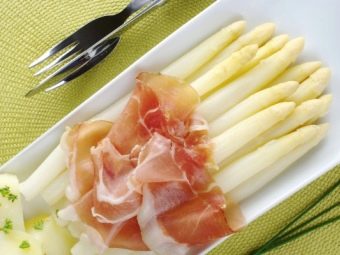White asparagus: properties and methods of cooking

Asparagus is a deli vegetable, which is at the peak of popularity, then remains in oblivion. At this time, asparagus is becoming popular again as a tasty and healthy product, and as a medicinal plant. This vegetable began to spread in Russia only about 3 centuries ago, and so far its cultivation in our country is not extensive enough, despite the simplicity of cultivation and the high benefit of this product.
What it is?
Asparagus is a perennial plant belonging to the asparagus family. Another name for this plant is asparagus. It can successfully grow in one area up to 20-25 years without transplants, a real garden survivor! The culture is frost-resistant, cultivation in central Russia does not bring any trouble. Asparagus can be found in the natural environment, the areas of distribution of its wild plantations are the Crimea, Europe, the Caucasus and Western Siberia. Wild asparagus is considered healthier and tastier than that grown in the garden.
In the garden area, asparagus is a spreading, strongly branching plant up to 2 meters high. Its leaves are very small and underdeveloped, resemble spruce needles. Many on this basis will be able to identify the plant, which is often found in gardens and orchards and is used to decorate autumn bouquets, this is asparagus. As a rule, this kind of asparagus is a medicinal variety of this plant.
But what does this branching herringbone have in common with edible short shoots? Quite simply, asparagus sprouts gather in the spring when they reach a length of about 15-20 centimeters. At this stage of growth, shoots and leaves have not yet formed at the shoots; therefore, the shoots are tender and juicy in taste, there are practically no fibers in them.
Asparagus has 3 varieties - white, green and purple (violet). The color of the shoots does not depend on the type of asparagus, it is caused by the method of cultivation. Green shoots are grown in the classical way, the shoots are collected very carefully, because they are quite tender and fragile. The soil at the bottom of the sprout is dug up a little, the place of attachment of the shoot to the root is located, it is cut off with a sharp knife, the stump remains about 2 centimeters.
Green asparagus is the most common, its taste is usually quite satisfying to consumers.
Lilac asparagus is invented by the French, it has a more piquant bitter taste than green. Sprouts of purple asparagus are collected at the moment when they only recently appeared above the level of the soil and have not yet become green.
The white variety of this vegetable is a delicacy; some time ago it was served only in expensive restaurants along with truffles and black caviar. This exquisite form of asparagus and will be discussed further.
What is different from green?
To get white asparagus over the asparagus bush make an artificial mound of soil. Thus, young shoots grow without the presence of sunlight. They are harvested as soon as the shoots begin to make their way through the soil, at this moment it will crack. Sprouts remain milky white, since they do not occur photosynthesis processes. Gourmets appreciate white asparagus for a milder taste and tenderness of texture than green and purple varieties of shoots.
The white variety of asparagus is the most expensive and noble, because the process of its cultivation is quite laborious, and you can get only about 250 grams of shoots from one adult asparagus bush. This is the reason for the high cost and value of this product.
Benefit and harm
Asparagus has a very extensive and rich vitamin and mineral composition.
It contains:
- vitamin A, vitamins of group B, nicotinic acid (PP), ascorbic acid (vitamin C), vitamin E, biotin;
- folic acid, which is essential during pregnancy and lactation;
- potassium, magnesium, sodium and calcium, regulating the work of the heart and blood vessels;
- iron, phosphorus and zinc, positively affecting the blood formation processes, the work of the nervous system, contributing to the prevention of osteoporosis, the body's ability to recover;
- a large amount of asparagine - a substance that dilates blood vessels and has a protective effect on the heart;
- fiber, which has a positive effect on the work of the gastrointestinal tract.
Asparagus is considered literally a healing vegetable, it has a mild diuretic and choleretic effect, helps with diseases of the joints, such as various kinds of rheumatism and gout. Asparagus sprouts have antifungal properties, due to the high content of vitamin C, it has a powerful antioxidant effect.
In addition to useful properties, asparagus has contraindications. It is necessary to refrain from eating asparagus shoots:
- with peptic ulcer disease;
- with a tendency to urolithiasis, since asparagus contributes to the accumulation of oxalates in the body;
- during the exacerbation of cystitis;
- with prostate;
- with individual intolerance of the product (sometimes causes allergic reactions).
Cooking Tips
The first step in cooking any dishes from asparagus is its heat treatment.
How to prepare the stems?
The recommendations are as follows.
- First you need to thoroughly wash the asparagus shoots, the scales on the head are often clogged with sand, since the white asparagus is completely covered with soil during the cultivation. Therefore, when it is impossible to wash the stem from the sand, the scales are removed.
- Next, the asparagus is cleared from the top layer, it is rather rough and hard. Therefore, the shoots need to be cleaned with high quality so that there are no areas covered with thick sandpaper.
- The lower part of the stem is cut by about a quarter, and if the fresh asparagus is cut to a fifth. Fresh asparagus is elastic, it bends without any problems and returns to its shape; moisture should appear at the cut.
- Shoots tied bundles and immersed in boiling water slices down. The upper part does not have to be covered with water, it is quite tender and can be boiled due to steam.
- Asparagus is cooked for about 10-15 minutes, salt and oil can be added to water to taste. It is important not to digest the vegetable, the shoots should stand upright the same way as at the beginning of the process.
- After cooking, immerse the boiled stems in a container with cold water.
- Purification remaining in the process is not thrown away, but used in further cooking, for example, in the preparation of soup or sauce. You can also use the water remaining in the cooking process.
Best recipes
The use of asparagus in cooking is quite universal, because from it you can cook and soup, and a side dish, and bake it, and fry, and marinate for the winter. At home, it is easy to cook delicious meals at a restaurant level using fresh asparagus shoots.
White Asparagus Cream Soup
Ingredients:
- white asparagus - 1 kg;
- milk - 3 cups;
- butter - 50 grams;
- flour - 30 grams;
- 3 yolks;
- parsley;
- salt, pepper - to taste.
Prepare the sprouts for cooking, boil for 20 minutes. The remaining decoction must be maintained. Cut the tips of the stems, leave to serve. The rest of the shoots cut and beat in a blender with a small amount of broth. You can optionally wipe through a sieve.
Take the remaining broth, add the amount of milk in it to a total of about 1 liter. Melt butter on the fire, add flour and stir for a couple of minutes. Next, pour a thin stream of broth with milk, without ceasing to stir, add the prepared mashed potatoes. Boil until thick.
For serving, take the soup bowl, put 1 yolk on the bottom and quickly beat with a fork, gradually pouring the soup. Garnish with the tips of the stems and chopped parsley.
Marinated
Ingredients:
- 1 kg of asparagus;
- 1.5 liters of water;
- 1 cup of honey;
- bell pepper;
- wine vinegar - 1 tablespoon.
Cooking marinade - mix water, honey, vinegar, pepper, bring to a boil. Stems must be well washed and cleaned, cut to the size of the container.Place the asparagus in the sterilized jars and pour the marinade to the top. Store the product in the refrigerator.
Baked
Ingredients:
- asparagus - 0.5 kg;
- milk - 200 ml;
- cream 35% - 100 ml;
- lemon - a quarter;
- flavored cheese (for example, parmesan) - 30 grams;
- salt, white pepper - to taste.
White asparagus to prepare, wash and clean, boil in a mixture of water and milk (for a glass of milk - 1.5 liters of water). Boil for 3 minutes, remove, dry. Place in a baking dish. Mix the cream, cheese and lemon juice, salt and pepper. Pour asparagus with this mixture and bake in the oven at 200 degrees. Bake until golden brown.
Boiled with hollandaise sauce
Asparagus is a fairly fragrant vegetable, so it is often used simply as boiled, adding a few sauces when serving. For example, the Dutch sauce is well suited, its delicate and smooth texture will be perfectly combined with such an exquisite vegetable.
Ingredients:
- 2 eggs;
- wine vinegar - 10 ml;
- lemon juice - 10 ml;
- butter - 110 g;
- salt, pepper - to taste.
Beat the yolks with a whisk with salt and pepper, heat the mixture of lemon juice and vinegar to a boil. Now you need to quickly pour the hot mixture into the yolks and mix well. Melt the butter and also add it to the mixture of yolks, vinegar and lemon juice in a thin stream. Beat the whites in a strong foam. Mix in the prepared mixture of proteins.
Asparagus shoots can be used in boiled form, and you can cook in a double boiler.
Sauce Option
There is another recipe for the original sauce, which is perfect for boiled asparagus.
Ingredients:
- 2 yolks;
- 1 spoon of mustard;
- 1 cup of vegetable oil;
- lemon juice or vinegar - 3 ml;
- pickled cucumber - 1 pc .;
- greens, salt, pepper - to taste.
Mix the yolks with lemon juice and mustard. Constantly stirring, pour in vegetable oil in a thin stream. The sauce will gradually thicken. When using a blender, the process will be faster than using a whisk. Salt the finished mixture, add finely chopped cucumber and greens (green onions work well).
For details on how to make a white asparagus sauté, see the video below.









































